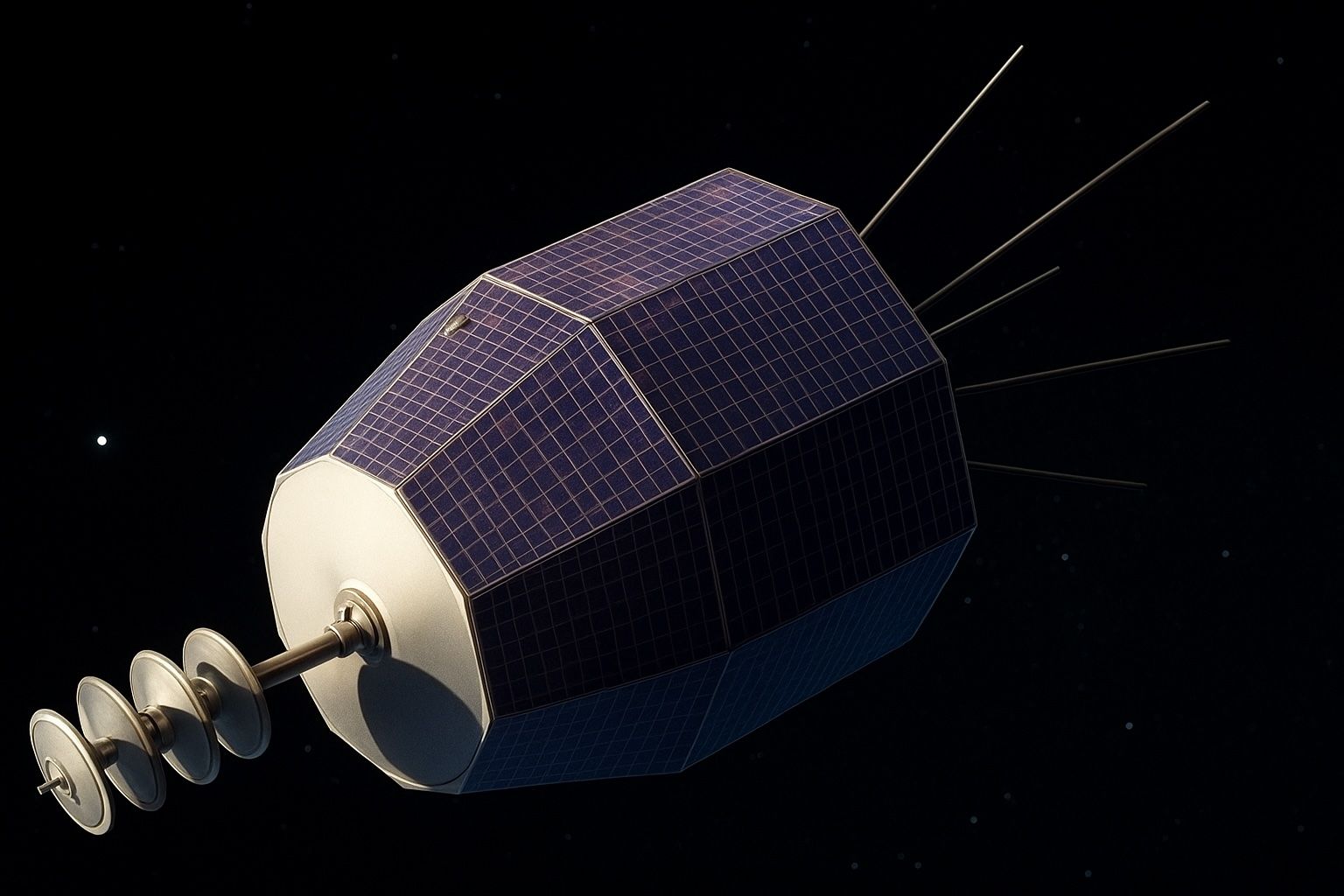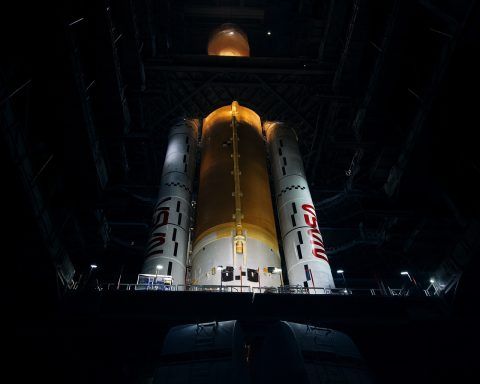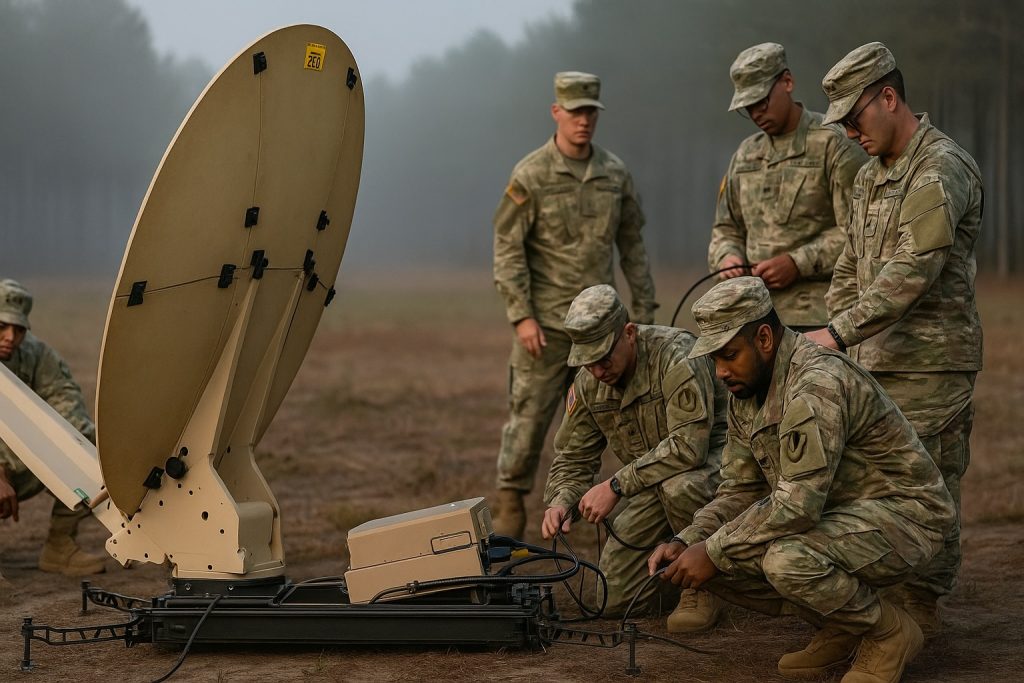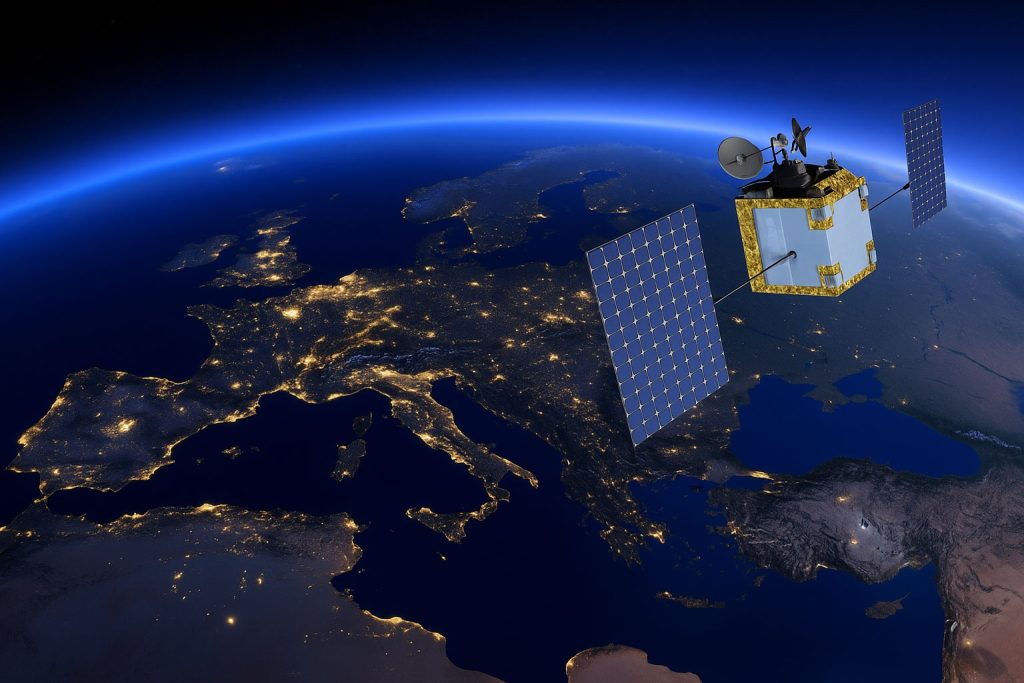- Relay-2 launched January 21, 1964 from Cape Canaveral as part of NASA’s Relay program to relay television and telemetry signals and study the Van Allen belts.
- Relay-2 operated 1964–1967, with the first transponder failing on November 20, 1966 and the second on June 9, 1967, after which it was retired.
- After deactivation, Relay-2 drifted in a medium Earth orbit of roughly 1,870 by 7,600 km.
- On June 13, 2024, ASKAP detected a radio burst lasting less than 30 nanoseconds, peaking at roughly 300,000–350,000 Jy, spanning 695–1,032 MHz.
- The event was traced to Relay-2 in near-Earth space using ASKAP’s near-field timing, indicating a local origin rather than a distant one.
- This marked a rare instance of a dead satellite rebroadcasting a radio signal about 60 years after deactivation.
- Two main hypotheses were proposed: an electrostatic discharge (ESD) from accumulated charge, or a micrometeoroid impact generating plasma and radio emission.
- The pulse’s dispersion was nearly zero, consistent with a near-Earth origin rather than an extragalactic fast radio burst.
- The event underscores that defunct satellites can produce false events for astrophysical transient searches and may aid space situational awareness.
- Findings were reported in June 2025 by New Scientist and chron.com ahead of formal publication in The Astrophysical Journal.
Astronomers were stunned when a 1960s NASA satellite suddenly “blinked” to life. On 13 June 2024, the Australian SKA Pathfinder (ASKAP) radio telescope in Western Australia detected an extraordinarily brief yet intense radio pulse lasting <30 nanoseconds and peaking at over 300,000 Jy [1] [2]. By tracing the signal in Earth’s vicinity (within ~12,400 miles altitude), researchers pinpointed the source as Relay-2 – a Cold War–era communications satellite launched in 1964 and silenced in the 1960s [3] [4]. This report breaks down Relay-2’s history, the sudden burst’s discovery and characteristics, scientists’ analyses, possible causes, and its broader significance and risks.
Mission History: Relay-2’s Life in Brief
- Launch (Jan 1964) – Relay-2 lifted off from Cape Canaveral on 21 January 1964 as part of NASA’s early communications research. Like its predecessor Relay-1, it was a spin-stabilized satellite designed to relay television and telemetry signals, and also carry instruments to study Earth’s Van Allen belts [5] [6].
- Operations (1964–1967) – Relay-2 operated nominally for only a few years. NASA reports that its first communications transponder failed on 20 Nov 1966, and the second worked until 9 June 1967 [7]. By late 1967 both payloads were dead, and the satellite was officially retired. (Ground stations were repurposed by Sept 1965, effectively ending Relay-2’s mission even earlier [8].)
- Silent Decades – After 1967 Relay-2 drifted silently in a medium Earth orbit (~1870×7600 km). It became one of thousands of inactive “zombie” satellites circling Earth [9]. (In fact, the Natural History Museum notes there are over 3,000 defunct satellites in orbit today.)
Timeline (key events):
- 21 Jan 1964: Relay-2 launched (Cape Canaveral) [10].
- Late 1965: NASA ends planned operations (ground station repurposed).
- 20 Nov 1966: First transponder fails [11].
- 9 Jun 1967: Second transponder fails; satellite goes silent [12].
- 13 Jun 2024: ASKAP detects a powerful ~30 ns radio pulse traced to Relay-2 [13] [14].
- Jun 2025: Findings reported by New Scientist/Chron (ahead of journal publication) [15] [16].
Relay-2’s hardware was never designed for long-term operations, so its rebroadcast of a radio signal 60 years later was entirely unexpected.
The 2024 Radio Pulse: What Happened?
On June 13, 2024 (UTC), ASKAP’s array of 36 dishes picked up a blindingly brief burst of radio waves [17] [18]. The burst had these properties:
- Duration: < 30 nanoseconds (one-billionth of a second) [19] [20].
- Bandwidth: Spanned roughly 695–1032 MHz [21] (within the UHF band).
- Strength: Peaked at ≈300,000–350,000 Jy [22] [23] (extraordinarily bright – briefly outshining all other celestial radio sources) [24] [25].
- Dispersion: Nearly none – the signal’s frequency sweep was consistent with a single Earth‐ionosphere passage, not a distant source [26].
Initially, astronomers like Curtin Univ. researcher Clancy James thought they might have discovered a new fast radio burst (FRB) or pulsar. “If it’s nearby, we can study it through optical telescopes really easily,” James told New Scientist, noting “we all got excited, thinking maybe we’d discovered a new pulsar” [27]. However, detailed analysis showed the pulse arrived without the kind of dispersion expected from an extragalactic FRB. Instead, the timing and direction were consistent with low Earth orbit rather than deep space [28]. Orbital modeling and timing delays traced the pulse back to Relay-2’s location in space [29] [30]. In short, a dead satellite was suddenly “blaring” into the radio sky for a split-second.
ASKAP’s detection of this pulse came during a monitoring campaign. In interviews, the team noted the signal “briefly outshone all other celestial radio sources” (on the sky) [31] [32]. After the flash, nothing more was heard – Relay-2 fell silent again, as mysteriously as it had blazed.
Analysis and Commentary
Space scientists quickly pored over the data. Clancy James (Curtin) and collaborators localized the burst to Relay-2 using the near-field timing capability of ASKAP [33] [34]. Given Relay-2’s instruments had been dead for decades, they concluded the pulse could not have been an intentional transmission [35]. The official relay station logic is that after deactivation, a satellite has no power; thus, any signal must be accidental.
Karen Aplin (University of Bristol) emphasized the broader context: as space gets crowded with debris and small satellites, unintentional pulses may become more common [36]. Radio astronomers have already learned to filter out man-made interference; however, transient bursts from objects like Relay-2 present a new challenge. “This kind of radio-based detection may prove valuable,” Aplin noted, since it can distinguish Earth-orbit sources from real astronomical phenomena [37].
Other experts have pointed out that Relay-2 isn’t the first “zombie satellite”. For example, the USAF’s LES-1 (dead since 1967) emitted detectable pulses in 2012, and the commercial Galaxy-15 satellite momentarily revived in 2010 after drifting off-station [38]. Amateur-radio AMSAT-OSCAR 7 (launched 1974) famously started working again in 2002. Each case has a different cause (e.g. battery realignments), but collectively they remind us that defunct satellites can sometimes transmit signals unexpectedly [39].
Importantly, NASA officials have not suggested any exotic origins for Relay-2’s pulse. Space agencies view the event as a technical curiosity. In fact, experts stress there is no evidence of intentional signals or intelligent design: “Given Relay-2’s systems have been inactive for decades, the burst could not have been a deliberate transmission,” and thus must have been accidental [40]. As one analysis bluntly notes, this is a natural space phenomenon – a very unusual one.
Possible Explanations
Scientists consider two main hypotheses, both involving sudden electrical discharges:
- Electrostatic Discharge (ESD): Over time, a satellite can accumulate static charge from solar radiation, Earth’s magnetic field, or charging interactions. If this charge suddenly discharges (like a mini lightning bolt on the spacecraft’s surface), it can produce a radio impulse. Weaker ESDs have been recorded by powerful telescopes before (e.g. Arecibo saw ~milliseconds-long bursts from spacecraft charging) [41] [42]. In Relay-2’s case, the accumulated charge could have built up over decades in orbit. When it finally overcame insulation, a brief discharge could have generated the nanosecond pulse. (The arXiv-published study specifically cites ESD as a plausible cause [43].)
- Micrometeoroid Impact: Another leading theory is that a tiny meteoroid (space dust) struck Relay-2 at high speed. The impact can vaporize material and create a hot plasma cloud around the satellite. This plasma can conduct and emit radio waves. Effectively, the collision would send a burst of electrons moving rapidly, radiating a pulse. Curtin’s team notes this scenario was also seen with manned spacecraft (e.g. a micrometeoroid hit the Soyuz, causing anomalies) [44]. Either way, a strike could have ionized part of the structure to produce the observed burst.
No evidence suggests more exotic theories (alien beacon, secret experiment, etc.) are needed. As Chron summarized: “Relay-2’s systems have been inactive for decades,” so the researchers “propose it resulted either from a sudden electrostatic discharge … or a micrometeorite striking the satellite” [45]. Both explanations fit known physics.
Other “Zombie” Signals: It’s worth noting past cases of reactivated satellites. In 2012 the US Air Force’s LES-1 (dead since 1967) began transmitting again due to battery-charging effects. Likewise, the comsat Galaxy 15 rebooted itself in 2010 after drifting out of position [46]. Even amateur radio satellites like OSCAR-7 have returned after decades. These tend to involve solar power or clock resets rather than ESD, but they show that “dead” satellites can occasionally send signals [47].
Relevance to Space Science and Radio Astronomy
Though dramatic, this event is scientifically useful rather than dangerous. It highlights how man-made objects can produce false positives in radio surveys. The Astrophysical Journal study explicitly notes that Relay-2’s pulse is a new class of “false event” for astrophysical transient hunters [48]. In practical terms, radio astronomers searching for fast radio bursts (FRBs) or pulsars must now consider that a local satellite could mimic such signals. Indeed, the detection of Relay-2’s flash relied on recognizing it as a near-field burst, not an extragalactic source [49] [50].
On the flip side, the result opens a new tool for space situational awareness. If radio telescopes can catch ESDs or impact flashes on silent satellites, they effectively become remote sensors for the space environment. As the authors suggest, this could allow remote monitoring of electrostatic discharges, which are known threats to spacecraft health [51]. It may also help in tracking micro-collision events. Karen Aplin noted that as low-cost sensors and mini-satellites proliferate, detecting such bursts “may prove valuable” in studying how debris and charging affect satellites [52].
There is no immediate risk to Earth from the radio pulse itself (radio waves pass harmlessly). But the implications for satellite safety are worth noting. Electrostatic events and micrometeoroid strikes can damage electronics. If a small piece of debris or space dust can briefly light up a defunct satellite, the same hazards threaten active ones. Designers of future spacecraft may use these findings to reinforce shielding or include discharge paths to avoid charge build-up. Also, agencies tracking space debris may consider radio-monitoring as part of debris detection strategies.
What’s Next?
The team’s findings have been submitted to The Astrophysical Journal. In the short term, astronomers will watch for repeat bursts (unlikely from the same satellite) and check if any other old satellites emit similar pulses. Dr. Clancy James and colleagues have opened up a new line of inquiry: watching the “radio heartbeat” of silent spacecraft.
Meanwhile, the space community will likely debate whether more such signals should be cataloged. Should radio observatories routinely filter out satellite-based bursts? How many FRB candidates might actually be Earth-orbit interlopers? This case serves as a real-world reminder that Earth’s orbital environment can directly intersect with astronomy.
In sum, the Relay-2 radio pulse is a curiosity that bridges planetary science, astrophysics, and engineering. It has already prompted experts to refine search techniques and consider space-weather phenomena. The full peer-reviewed paper (now on arXiv) concludes that “[s]pace-charging events pose a serious threat to spacecraft, and also reveal a new source of false events for observations of astrophysical transients” [53]. By quoting the unthinkable – a “dead” satellite speaking out – this episode underscores that even long-silent relics of the Space Age can yield fresh insights today.
Sources: Credible media reports and the accepted scientific preprint (Curtin Univ. et al., 2025). Key references include Chron (Houston Chronicle) coverage [54] [55], IFLScience [56] [57], Fox Weather [58] [59], the arXiv paper [60] [61], and related expert analysis [62] [63]. These detail Relay-2’s history, the June 2024 detection, scientific interpretations, and context. All information is drawn from these up-to-date, authoritative sources.
References
1. www.chron.com, 2. www.n2yo.com, 3. www.chron.com, 4. www.n2yo.com, 5. www.foxweather.com, 6. www.iflscience.com, 7. www.foxweather.com, 8. www.iflscience.com, 9. www.n2yo.com, 10. www.foxweather.com, 11. www.foxweather.com, 12. www.foxweather.com, 13. www.chron.com, 14. www.n2yo.com, 15. www.n2yo.com, 16. www.chron.com, 17. www.chron.com, 18. www.n2yo.com, 19. www.chron.com, 20. www.n2yo.com, 21. arxiv.org, 22. www.chron.com, 23. arxiv.org, 24. www.chron.com, 25. www.n2yo.com, 26. arxiv.org, 27. www.chron.com, 28. www.chron.com, 29. www.chron.com, 30. www.iflscience.com, 31. www.chron.com, 32. www.n2yo.com, 33. www.chron.com, 34. www.n2yo.com, 35. www.chron.com, 36. www.chron.com, 37. www.chron.com, 38. www.iflscience.com, 39. www.iflscience.com, 40. www.chron.com, 41. www.iflscience.com, 42. arxiv.org, 43. arxiv.org, 44. www.iflscience.com, 45. www.chron.com, 46. www.iflscience.com, 47. www.iflscience.com, 48. arxiv.org, 49. arxiv.org, 50. www.chron.com, 51. arxiv.org, 52. www.chron.com, 53. arxiv.org, 54. www.chron.com, 55. www.chron.com, 56. www.iflscience.com, 57. www.iflscience.com, 58. www.foxweather.com, 59. www.foxweather.com, 60. arxiv.org, 61. arxiv.org, 62. www.n2yo.com, 63. www.n2yo.com





